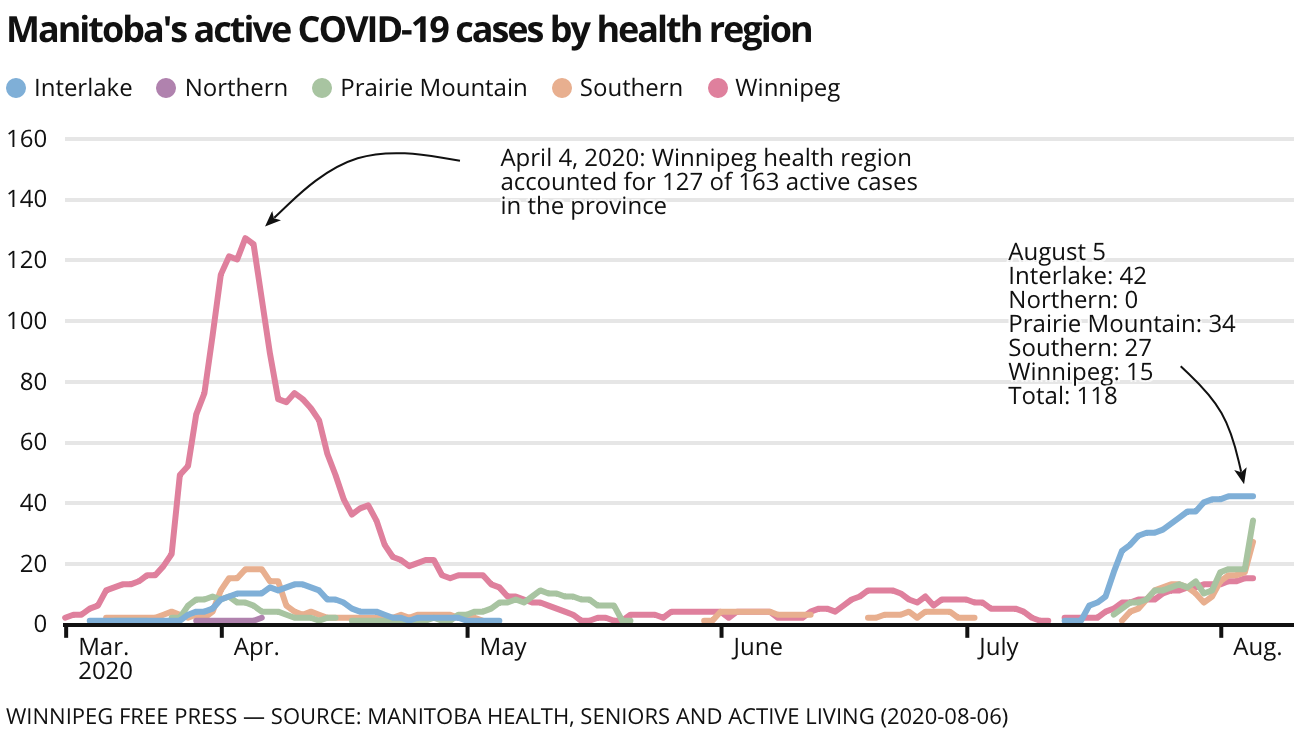Business
Province reports 30 new COVID cases; four Maple Leaf workers among 18 in Brandon – Winnipeg Free Press

Manitoba’s chief public health officer cut short his vacation Thursday to deliver the bad news of 30 new COVID-19 cases, including a cluster of 18 in Brandon.
The large number of cases in Manitoba’s second-largest city are linked to a person who travelled from Eastern Canada and didn’t strictly follow self-isolation guidelines, Dr. Brent Roussin said.
“The person was to have self-isolated and it wasn’t done perfectly and we saw transmission occur,” he said. “Self-isolation isn’t only staying home, it’s also limiting your contact with other people in the home,” he added, without providing more details.
Eleven other cases were reported in the province’s Southern Health region. One new case was reported in Winnipeg.
It was the highest single-day coronavirus count in the province since April 2, when 40 cases were reported.
“Today’s case numbers are a reminder that COVID 19 is not done with us — that we still need to take… fundamental precautions,” Roussin said.
Four of the new cases in Brandon are people employed at the Maple Leaf Foods Inc. hog processing plant, reported Local 832 of the United Food and Commercial Workers Union, which represents them.
The union wants the plant shut down, at least until Monday. An estimated 76 plant workers have been tested thus far.
“>
Four of the new cases in Brandon are people employed at the Maple Leaf Foods Inc. hog processing plant, reported Local 832 of the United Food and Commercial Workers Union, which represents them. (Bruce Bumstead / Brandon Sun files)
“We strongly believe that the most prudent action is to cease production until more test results come back and we have a better sense of the trend,” Local 832 president Jeff Traeger said in a letter Thursday to provincial Health Minister Cameron Friesen.
However, the province decided against a shutdown of the facility, which employs 2,300 workers.
“We’re not seeing evidence of transmission occurring in the workplace,” said Roussin, who wouldn’t provide any details about the tested employees.
“The industry itself has gone above and beyond what public health has recommended.”
Friesen told reporters that a decision to protect workers’ safety, such as closing the plant, will be based on evidence and accurate information that’s verified by public health officials.
Maple Leaf says it’s taking precautions and has no plan to cease production. The company says the workers appear to have contracted the virus in the community.
“We will continue to operate our Brandon plant as long as we believe we can provide an environment that will protect the safety of our people while working,” the company said in an email to the Free Press Thursday.
“Given our daily health screening, temperature monitoring, social distancing and the personal protective equipment all team members wear while at work, we feel confident that our plant environment is safe.”
Health officials said Thursday that 10 Manitobans were hospitalized with COVID-19, five of them in intensive care. There are 118 active cases. The total infected so far in the province since the pandemic began is now 474. With the newly identified infections, the five-day test positivity rate rose to 0.90 per cent.
“>
The province decided against a shutdown of the Maple Leaf Foods Inc. hog processing plant in Brandon, which employs 2,300 workers. (Tim Smith / The Brandon Sun)
NDP Leader Wab Kinew said the government should be providing more precise information about the location of COVID-19 cases and whether they are tied to specific workplaces.
While the province says there is no evidence that the coronavirus is being spread at Maple Leaf, the fact remains that “more and more employees are falling sick at that plant,” he said. Both he and and Liberal Leader Dougald Lamont supported the UFCW’s call Thursday for a temporary closure.
The government’s reluctance to name institutions where infections have occurred (unless it needs the public’s help to trace contacts) may become “a big concern” once school season arrives, Kinew said.
Parents will want to know if there are cases linked to their child’s school or daycare, he said. “Right now, it seems as though you’ll only be notified if there was a close contact (to your child).”
Lamont said close attention must be paid to the Maple Leaf plant because most of the large COVID-19 outbreaks in North America have been tied to either meat-packing plants or personal-care homes.
Age breakdown of latest COVID-19 cases
Click to Expand
Among the 30 new COVID-19 cases announced by the province on Thursday, four were children aged nine and younger — two from Brandon and two from the Southern Health region.
Four other young people, aged 10 to 19, were also identified in the latest group of infections — three from Brandon in the Prairie Mountain Health region and one in Southern Health.
Of the 30 new cases, six are people aged 60 and older, including one man in his 80s.
Among the rest, six cases were people in their 20s, six were in their 30s and four in their 40s. None who were infected was in their 50s.
If the plant itself isn’t the source of the virus spread, the focus should nonetheless be on its workforce, many of whom are likely living in cramped quarters, he said.
“There needs to be a full screen of all the employees,” he said.
Maple Leaf said its plants have “transformed” how they operate through social distancing, with “plexiglass separators on production lines where possible, marks on floors to control movement in certain directions and efforts to decrease density, like staggered shifts and additional break space.”
After learning of the positive test results, Maple Leaf implemented a COVID-19 response plan and asked several other “team members” to self-quarantine. The company notified employees, the Canada Food Inspection Agency and the union, a spokesperson said.
“After a careful and detailed review of the circumstances around the cases, it appears very likely that the team members contracted COVID-19 in the community,” the spokesperson said, adding the company is in contact with the four infected employees, who are all recovering at home.
But it took just a few positive cases at other food processing plants in Canada and the U.S. to turn quickly into major outbreaks that resulted deaths, the union president said.
“We’re trying to prevent a disaster,” said Traeger.
![]()
![]()
Some workers have said they’re scared of catching the virus on the job, and Traeger expects to see the rate of absenteeism rise until their fears are allayed.
Three of the workers who tested positive worked in the same auxiliary department — not the slaughterhouse or on the production line. None of the four who’ve tested positive are being paid, contrary to what Traeger said the union was told earlier by a Maple Leaf manager.
“The company is not paying a salary to people who have COVID-19 or are self-isolating,” he said.
Traeger said he can see why the company isn’t acting quickly to close the Brandon plant that kills up to 18,000 hogs a day. It provides the pork to Maple Leaf’s processing facilities across Canada, and closing it could cripple other plants.
“That’s a lot of revenue,” he said.
carol.sanders@freepress.mb.ca
larry.kusch@freepress.mb.ca


Carol Sanders
Reporter
Carol Sanders’ reporting on newcomers to Canada has made international headlines, earned national recognition but most importantly it’s shared the local stories of the growing diversity of people calling Manitoba home.


Larry Kusch
Legislature Reporter
Larry Kusch didn’t know what he wanted to do with his life until he attended a high school newspaper editor’s workshop in Regina in the summer of 1969 and listened to a university student speak glowingly about the journalism program at Carleton University in Ottawa.
Business
Why the Bank of Canada decided to hold interest rates in April – Financial Post
Article content
Divisions within the Bank of Canada over the timing of a much-anticipated cut to its key overnight interest rate stem from concerns of some members of the central bank’s governing council that progress on taming inflation could stall in the face of stronger domestic demand — or even pick up again in the event of “new surprises.”
“Some members emphasized that, with the economy performing well, the risk had diminished that restrictive monetary policy would slow the economy more than necessary to return inflation to target,” according to a summary of deliberations for the April 10 rate decision that were published Wednesday. “They felt more reassurance was needed to reduce the risk that the downward progress on core inflation would stall, and to avoid jeopardizing the progress made thus far.”
Article content
Others argued that there were additional risks from keeping monetary policy too tight in light of progress already made to tame inflation, which had come down “significantly” across most goods and services.
Some pointed out that the distribution of inflation rates across components of the consumer price index had approached normal, despite outsized price increases and decreases in certain components.
“Coupled with indicators that the economy was in excess supply and with a base case projection showing the output gap starting to close only next year, they felt there was a risk of keeping monetary policy more restrictive than needed.”
In the end, though, the central bankers agreed to hold the rate at five per cent because inflation remained too high and there were still upside risks to the outlook, albeit “less acute” than in the past couple of years.
Despite the “diversity of views” about when conditions will warrant cutting the interest rate, central bank officials agreed that monetary policy easing would probably be gradual, given risks to the outlook and the slow path for returning inflation to target, according to the summary of deliberations.
Article content
They considered a number of potential risks to the outlook for economic growth and inflation, including housing and immigration, according to summary of deliberations.
The central bankers discussed the risk that housing market activity could accelerate and further boost shelter prices and acknowledged that easing monetary policy could increase the likelihood of this risk materializing. They concluded that their focus on measures such as CPI-trim, which strips out extreme movements in price changes, allowed them to effectively look through mortgage interest costs while capturing other shelter prices such as rent that are more reflective of supply and demand in housing.
Recommended from Editorial
They also agreed to keep a close eye on immigration in the coming quarters due to uncertainty around recent announcements by the federal government.
“The projection incorporated continued strong population growth in the first half of 2024 followed by much softer growth, in line with the federal government’s target for reducing the share of non-permanent residents,” the summary said. “But details of how these plans will be implemented had not been announced. Governing council recognized that there was some uncertainty about future population growth and agreed it would be important to update the population forecast each quarter.”
• Email: bshecter@nationalpost.com
Bookmark our website and support our journalism: Don’t miss the business news you need to know — add financialpost.com to your bookmarks and sign up for our newsletters here.
Share this article in your social network
Business
Meta shares sink after it reveals spending plans – BBC.com


Shares in US tech giant Meta have sunk in US after-hours trading despite better-than-expected earnings.
The Facebook and Instagram owner said expenses would be higher this year as it spends heavily on artificial intelligence (AI).
Its shares fell more than 15% after it said it expected to spend billions of dollars more than it had previously predicted in 2024.
Meta has been updating its ad-buying products with AI tools to boost earnings growth.
It has also been introducing more AI features on its social media platforms such as chat assistants.
The firm said it now expected to spend between $35bn and $40bn, (£28bn-32bn) in 2024, up from an earlier prediction of $30-$37bn.
Its shares fell despite it beating expectations on its earnings.
First quarter revenue rose 27% to $36.46bn, while analysts had expected earnings of $36.16bn.
Sophie Lund-Yates, lead equity analyst at Hargreaves Lansdown, said its spending plans were “aggressive”.
She said Meta’s “substantial investment” in AI has helped it get people to spend time on its platforms, so advertisers are willing to spend more money “in a time when digital advertising uncertainty remains rife”.
More than 50 countries are due to have elections this year, she said, “which hugely increases uncertainty” and can spook advertisers.
She added that Meta’s “fortunes are probably also being bolstered by TikTok’s uncertain future in the US”.
Meta’s rival has said it will fight an “unconstitutional” law that could result in TikTok being sold or banned in the US.
President Biden has signed into law a bill which gives the social media platform’s Chinese owner, ByteDance, nine months to sell off the app or it will be blocked in the US.
Ms Lund-Yates said that “looking further ahead, the biggest risk [for Meta] remains regulatory”.
Last year, Meta was fined €1.2bn (£1bn) by Ireland’s data authorities for mishandling people’s data when transferring it between Europe and the US.
And in February of this year, Meta chief executive Mark Zuckerberg faced blistering criticism from US lawmakers and was pushed to apologise to families of victims of child sexual exploitation.
Ms Lund-Yates added that the firm has “more than enough resources to throw at legal challenges, but that doesn’t rule out the risks of ups and downs in market sentiment”.
Business
Oil Firms Doubtful Trans Mountain Pipeline Will Start Full Service by May 1st
|
|


Oil companies planning to ship crude on the expanded Trans Mountain pipeline in Canada are concerned that the project may not begin full service on May 1 but they would be nevertheless obligated to pay tolls from that date.
In a letter to the Canada Energy Regulator (CER), Suncor Energy and other shippers including BP and Marathon Petroleum have expressed doubts that Trans Mountain will start full service on May 1, as previously communicated, Reuters reports.
Trans Mountain Corporation, the government-owned entity that completed the pipeline construction, told Reuters in an email that line fill on the expanded pipeline would be completed in early May.
After a series of delays, cost overruns, and legal challenges, the expanded Trans Mountain oil pipeline will open for business on May 1, the company said early this month.
“The Commencement Date for commercial operation of the expanded system will be May 1, 2024. Trans Mountain anticipates providing service for all contracted volumes in the month of May,” Trans Mountain Corporation said in early April.
The expanded pipeline will triple the capacity of the original pipeline to 890,000 barrels per day (bpd) from 300,000 bpd to carry crude from Alberta’s oil sands to British Columbia on the Pacific Coast.
The Federal Government of Canada bought the Trans Mountain Pipeline Expansion (TMX) from Kinder Morgan back in 2018, together with related pipeline and terminal assets. That cost the federal government $3.3 billion (C$4.5 billion) at the time. Since then, the costs for the expansion of the pipeline have quadrupled to nearly $23 billion (C$30.9 billion).
The expansion project has faced continuous delays over the years. In one of the latest roadblocks in December, the Canadian regulator denied a variance request from the project developer to move a small section of the pipeline due to challenging drilling conditions.
The company asked the regulator to reconsider its decision, and received on January 12 a conditional approval, avoiding what could have been another two-year delay to start-up.





-
News23 hours ago
Amid concerns over ‘collateral damage’ Trudeau, Freeland defend capital gains tax change
-
Art21 hours ago
The unmissable events taking place during London’s Digital Art Week
-



 Politics24 hours ago
Politics24 hours agoPolitics Briefing: Saskatchewan residents to get carbon rebates despite province’s opposition to pricing program
-
News22 hours ago
What is a halal mortgage? How interest-free home financing works in Canada
-



 Politics16 hours ago
Politics16 hours agoOpinion: Fear the politicization of pensions, no matter the politician
-
Economy21 hours ago
German Business Outlook Hits One-Year High as Economy Heals
-
Media14 hours ago
B.C. puts online harms bill on hold after agreement with social media companies
-



 Politics15 hours ago
Politics15 hours agoPecker’s Trump Trial Testimony Is a Lesson in Power Politics














